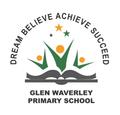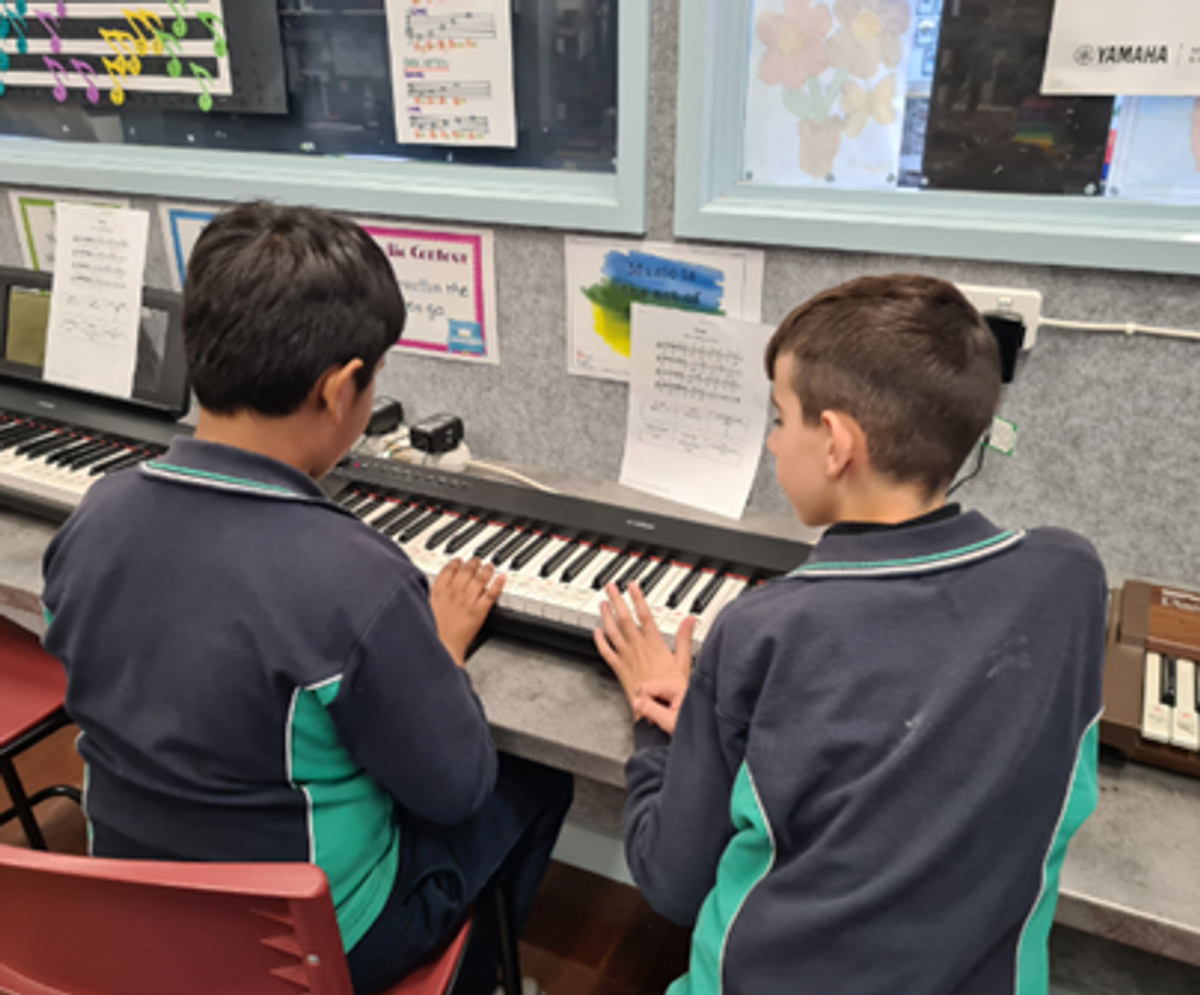Music

This term we are focusing on developing skills such as beat, ensemble playing, rhythm and note reading.
Years 3 and 4 students auditioned late last year and early this year for Mass Choir in the Victorian State School Spectacular. We are extremely excited to have finally been given our music for the performance and are getting in to learning and practising it as a choir of 30!
Year 5 and 6 Music Innovation will also take place this term with the 20 selected students extending their musical learning outside of regular music classes.
Prep
In Term Two, Prep students will commence a unit on beat, focusing on how we count the beats to help us stay at the same speed. Prep students will be using untuned percussion such as clave and handheld drums to help them develop this skill. They will work on their counting skills and transfer these to count the beats in various songs. Prep students will transition into discerning the different sound that crotchets (ta’s) and quavers (ti-ti’s) make. They will focus on differentiating these various sounds through a range of learning tasks designed to build confidence and skill level.
Curriculum Links:
- Rehearse and perform songs and short instrumental pieces which they have learnt and composed (VCAMUP0One9)
- Rehearse and perform songs and short instrumental pieces which they have learnt and composed (VCAMUP0One9)
Key Vocabulary:
Beat, Counting, Crotchets (ta’s) and Quavers (ti-ti’s)
Year 1
In Term Two, Year One students will be beginning a unit on the Solfege notes (do, re, mi, fa etc). They will focus on learning each of the 8 Solfege notes and transferring them to the tone ladder. Students will also be introduced to crotchet rests (za). They will explore these rests through games and songs experimenting with both sound and silence in music. Students will be using BoomWhackers, Glockenspiels and their singing voices to consolidate this knowledge of both Solfege notes and crotchet rests throughout the term.
Curriculum Links:
- Rehearse and perform songs and instrumental music they have learnt and composed to communicate ideas to an audience (VCAMUP023)
- Sing and play instruments to improvise, compose and practise a repertoire of chants, songs and rhymes, including those used by cultural groups in the local community (VCAMUM022)
Key Vocabulary:
Crotchet rest, Solfege, BoomWhackers, Glockenspiels
Year 2
In Term Two, Year 2 students will undertake a unit on ensemble playing focusing on the skills needed to play together. Year 2 students will be using BoomWhackers, Xylophones, Glockenspiels and Metallophones to help them develop their ensemble skills. They will learn the song ‘Autumn Leaves’ on each of these instruments before learning to play it in small groups with one of each instrument. Year 2 students will practise their ensemble skills by using not just one instrument but by having a turn at each instrument within the ensemble. They will focus on these ensemble skills such as listening, keeping the beat, and counting through a variety of learning tasks designed to build confidence.
Curriculum Links:
- Rehearse and perform songs and instrumental music they have learnt and composed to communicate ideas to an audience (VCAMUP023)
- Sing and play instruments to improvise, compose and practise a repertoire of chants, songs and rhymes, including those used by cultural groups in the local community (VCAMUM022)
Key Vocabulary:
Ensemble skills, Beat, Listening, Counting
Year 3
Throughout Term Two, Year 3 students will undertake a unit on form (structure). They will learn 3 different forms including binary form, ternary form and rondo form. Students will be introduced to many different songs such as ‘Greensleeves’, ‘The Noble Duke of York’ and ‘Fur Elise’ that change have varying forms. This will give students the opportunity to transfer their knowledge of binary, ternary and rondo form to instruments. Throughout the term students will also be introduced to a new note called semiquavers (tika-tika). Students will transfer their learning of semiquavers to play various songs on instruments such as Piano, Xylophone and Glockenspiel. They will focus on counting their beats to learn it more effectively ensuring they play the correct rhythm.
Curriculum Links:
- Use voice and instruments to sing, play and arrange music from different cultures, times and locations, and improvise and compose music in different forms (VCAMUM026)
- Use imagination and creativity to explore pitch, rhythm/time and form, dynamics and tempo using voice, movement and instruments (VCAMUE025)
Key Vocabulary:
Ternary, Binary, Rondo, Semiquavers
Year 4
In Term Two, Year 4 students will commence a unit about the Elements of Music (duration, pitch, form, texture, expression, and tone/timbre). Students will learn about one of the Elements of Music each week. They will then practise this Element of Music through instruments learning various songs. As the term progresses students will use more of the Elements of Music until they can add all 6 to a song of their choosing. They will transfer their knowledge of the elements by adding expression (the way the song is played), varying beats, harmony and texture to the song when playing it on various instruments. Students will focus on using the Elements of Music that will enhance the song the most to make it more enjoyable for the audience.
Curriculum Links:
- Use voice and instruments to sing, play and arrange music from different cultures, times and locations, and improvise and compose music in different forms (VCAMUM026)
- Rehearse and perform songs and instrumental music they have learnt and composed, shaping elements of music to communicate ideas to an audience (VCAMUP027)
Key Vocabulary:
Elements of Music, Duration, Pitch, Form, Texture, Expression, Tone/Timbre
Year 5
Throughout Term Two, Year 5 students will undertake a unit in Drumming focusing on both simple and complex rhythmic patterns. Students will begin by learning simple rhythms using the top, rim, sides and sticks of the drum. They will also ensure they are continuing to use the correct hand (either right or left) when playing rhythms. When learning songs students will be transferring their prior knowledge of notes to make certain they are playing the correct rhythm. As the term progresses students will learn more complex rhythms and songs. Throughout the term Year 5 students will not only focus on playing the correct rhythm but also keeping a steady beat to ensure they can play as one drum ensemble.
Curriculum Links:
- Explore ways of combining the elements of music using listening skills, voice and a range of instruments, objects and electronically generated sounds to create effects (VCAMUE029)
- Develop and practise technical skills and use of expressive elements of music in singing, playing instruments, improvising, arranging and composing (VCAMUM030)
- Rehearse and perform songs and music they have learnt, including their own compositions, combining aspects of the elements of music and using performance skills, to communicate ideas and intentions to an audience (VCAMUP031)
Key Vocabulary:
Rhythm, Ensemble, Top, Rim, Sides, Sticks
Year 6
In Term Two, Year 6 students will commence a unit on ensemble (group) playing. Students will be learning the song ‘Wellerman’ on 3 different instruments (BoomWhackers, Guitar and Drums). They learn the song on each instrument before exploring the skills necessary (listening, counting, and keeping the beat) to play together in a small ensemble. Students who learn an instrument outside of school will form their own small ensemble playing a song that is at their level. They will then transfer this knowledge of ensemble playing to the song they learnt to perform them both as a small group and as a class. Students will focus on their beat skills ensuring that although they are playing different instruments and different notes they are playing together at the same speed.
Curriculum Links:
- Explore ways of combining the elements of music using listening skills, voice and a range of instruments, objects and electronically generated sounds to create effects (VCAMUE029)
- Develop and practise technical skills and use of expressive elements of music in singing, playing instruments, improvising, arranging and composing (VCAMUM030)
- Rehearse and perform songs and music they have learnt, including their own compositions, combining aspects of the elements of music and using performance skills, to communicate ideas and intentions to an audience (VCAMUP031)
Key Vocabulary:
Ensemble, Beat, BoomWhackers, Guitar, Drums
How can you support your child’s Music learning at home?
- Listen to a genre of music you have never listened to before such as Jazz!
- Experiment with sound and silence. This could be with instruments you own or through games such as musical statues.
- When listening to music, see if you can pick out the beat and tap it on your legs.

